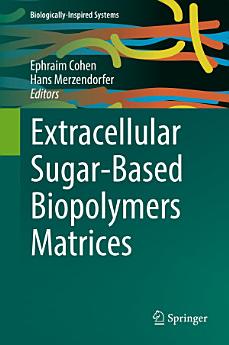Extracellular Sugar-Based Biopolymers Matrices
Despre această carte electronică
The extracellular matrix (ECM) is an acellular three-dimensional network composed of proteins, glycoproteins, proteoglycans and exopolysaccharides. It primarily serves as a structural component in the tissues and organs of plants and animals, or forms biofilms in which bacterial cells are embedded. ECMs are highly dynamic structures that undergo continuous remodeling, and disruptions are frequently the result of pathological processes associated with severe diseases such as arteriosclerosis, neurodegenerative illness or cancer. In turn, bacterial biofilms are a source of concern for human health, as they are associated with resistance to antibiotics. Although exopolysaccharides are crucial for ECM formation and function, they have received considerably little attention to date.
The respective chapters of this book comprehensively address such issues, and provide reviews on the structural, biochemical, molecular and biophysical properties of exopolysaccharides. These components are abundantly produced by virtually all taxa including bacteria, algae, plants, fungi, invertebrates and vertebrates. They include long unbranched homopolymers (cellulose, chitin/chitosan), linear copolymers (alginate, agarose), peptoglycans such as murein, heteropolymers like a variety of glycosaminoglycans (hyaluronan, dermatan, keratin, heparin, Pel), and branched heteropolymers such as pectin and hemicellulose.
A separate chapter is dedicated to modern industrial and biomedical applications of exopolysaccharides and polysaccharide-based biocomposites. Their unique chemical, physical and mechanical properties have attracted considerable interest, inspired basic and applied research, and have already been harnessed to form structural biocomposite hybrids for tailor-made applications in regenerative medicine, bioengineering and biosensor design.
Given its scope, this book provides a substantial source of basic and applied information for a wide range of scientists, as well as valuable textbook for graduate and advanced undergraduate students.
Despre autor
Ephraim Cohen is a Professor Emeritus of the Hebrew University of Jerusalem in the discipline of pesticide toxicology. He published a large number of articles and book chapters on the subject of chitin synthesis and inhibition. He is the editor of two volumes (44 and 46) titled "Target Receptors in the Control of Insect Pests" in Advances in Insect Physiology (Academic Press, 2013 and 2014). He is the editor of the recent successful book: "Extracellular Composite Matrices in Arthropods" published by Springer in 2016.
Hans Merzendorfer is appointed as a Professor of Molecular Biology at the University of Siegen, Germany. His research interests are centered on the physiological functions of different membrane proteins including beta-glycosyltransferases involved in the biosynthesis of chitin. He has published about one hundred research articles, reviews, scientific columns and book chapters. He is a current member of the editorial boards of Insect Biochemistry and Molecular Biology and Frontiers in Zoology, and speaker of the section of Physiology of the German Zoological Society.





